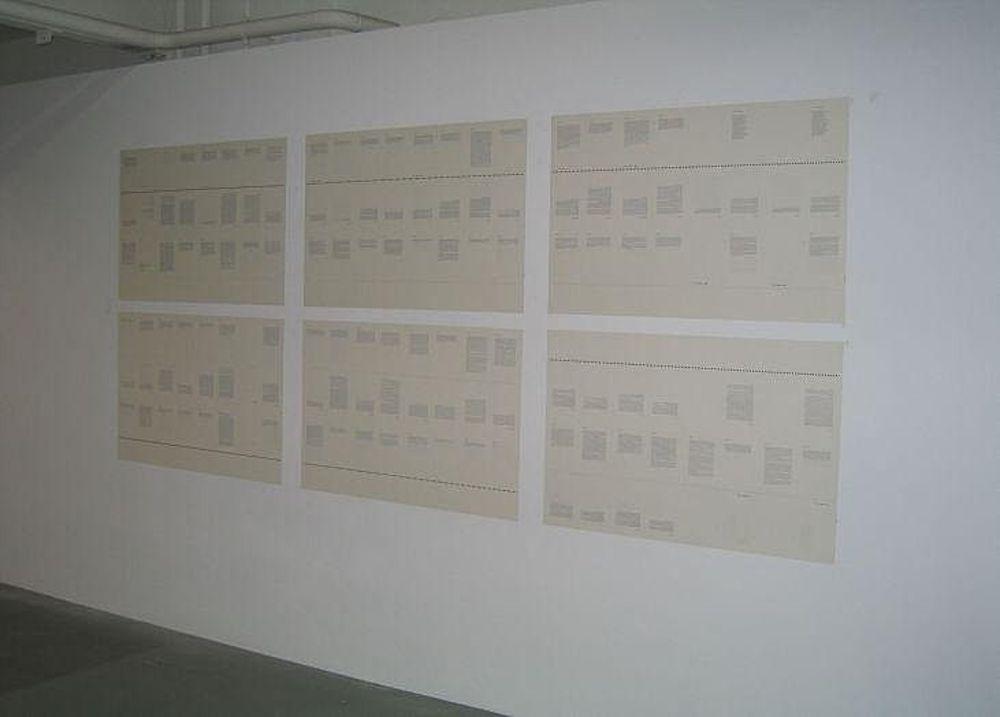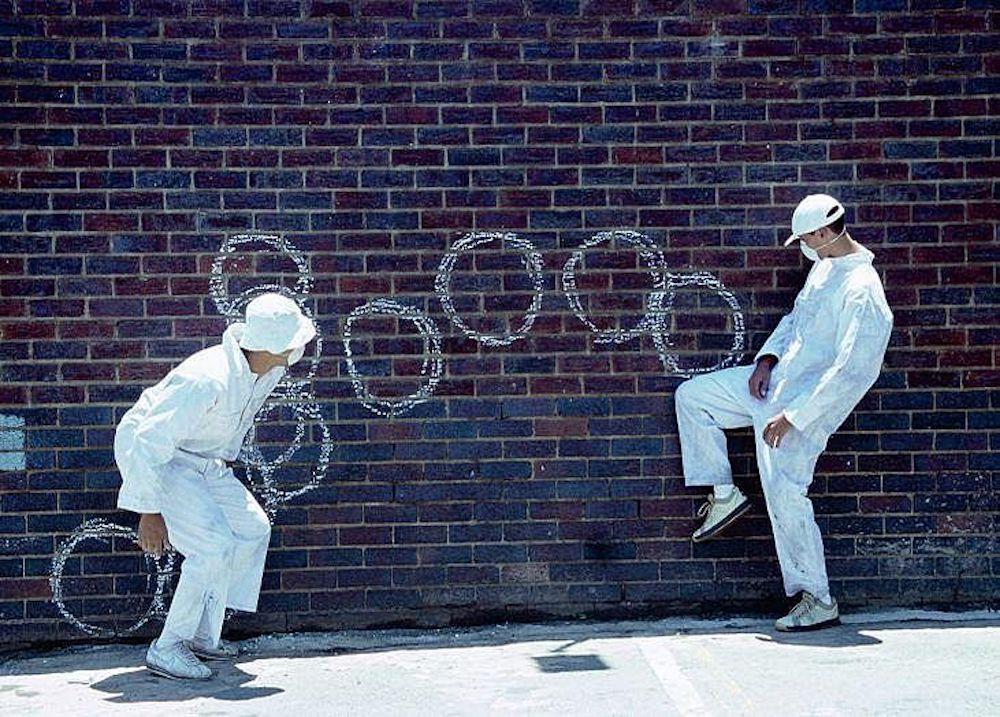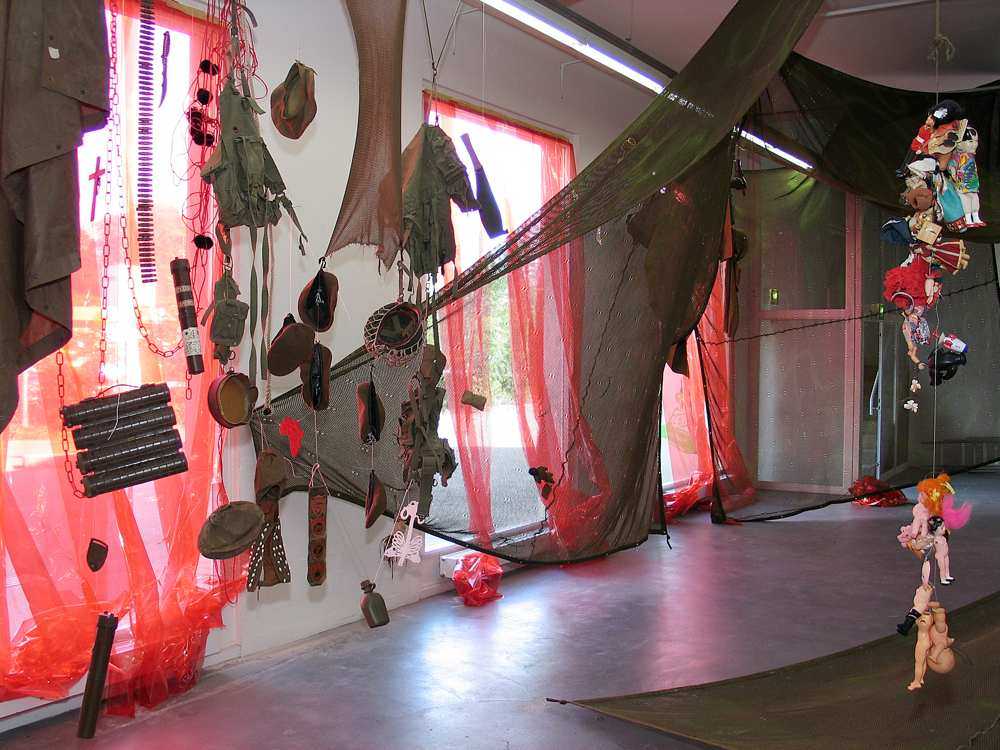Min(e)dfields
8.8. —
19.11.2004
A project by Sabine Schaschl-Cooper, Stephen Hobbs, Katrien Reist van Gelder and Beate Engel in cooperation with Stadtgalerie Bern and The Gallery Premises Johannesburg. The close cultural interactions that have existed between South Africa and Switzerland for the past five years constitute the conceptual framework of the Min(e)dfields project, bringing together curators, art critics, and artists of both countries.
Min(e)dfields is a cooperation project between Kunsthaus Baselland (Muttenz), Stadtgalerie (Berne), and Premises Gallery (Johannesburg). Under this heading, all three institutions put on display a selection of artworks that is specifically geared towards the place in question, its basic concept, its mode of functioning, and its impact on the region surrounding it. A few works are shown in all three institutions and thus provide for some continuity. The ambiguous title leaves room for many interpretations, fuelling discussions and evoking different associations. These include references to the minefields of South Africa, and to the economic exploitation of the country and its people by the wealthy and their allies in Western countries. The title also alludes to ‘mind-fields’ left behind by the political monstrosity of the Apartheid regime. The latter, even though it officially ended following a change of government, is still perceived as a grim legacy that impinges on today’s society and the way it is run. Heated debates flare up again and again as mined fields seem to be on the brink of explosion. Nevertheless, ten years of democracy have paved the way towards an international public discourse on the upheavals that have occurred. Min(e)dfields explores the complexity of navigating through unchartered social and political territory, an exercise that requires different levels of commitment, adaptation, and interpretation. Underneath the waves of forward-looking optimism, vibrations of unstable and sensitive currents are well noticeable to which Min(e)dfields responds by elucidating the role of art in redefining a democratic society. The exhibition concept at Kunsthaus Baselland focuses on how the West tends to perceive contemporary South African art, and on attempts to challenge prevailing prejudices.

Monika Dillier, who was born in 1947 in Obwalden/Switzerland and currently lives in Basel, creates painted or drawn works on paper and photographs having different formats, depicting contemporary news events as well as imagery originating in memories. The artist describes her approach as follows: “I draw what I like to see. But I often don’t know why I like what I see. […] It fills me with happiness and joy to like looking at something even though I don’t understand it. In this respect, drawing is tantamount to imitating.” Prior to taking a trip to South Africa, Dillier created works that revolve around both her mental preparations and the expectations she placed in this country unknown to her, yet associated with images conveyed by the media. In Boat People, Dillier focuses on an alarming social phenomenon — refugees torn between the desire to lead a new and better life and their great fear of what awaits them. The picture shows to what an extent such people trapped in a boat, with searchlights zooming in on them, are at the mercy of those apprehending them. During her stay in Cape Town a newspaper clipping attracted her attention, eventually leading to several paper works. A young woman living in a township has put on her best clothes to celebrate a certain occasion. In several works her colorful dress becomes a symbol of a moment relived. Monika Dillier does not want to document but to capture images marked by objective and subjective elements, current and past meanings, or particular contexts.

Peter Friedl’s (born in 1960 in Oberneukirchen/Austria, lives in Berlin) project Four or Five Roses centers on talks the artist had in the course of three years on playgrounds in Johannesburg, Cape Town, and in the surrounding townships. The stories told by the four- to fourteen-year old children he interviewed were translated from various South African languages (there are eleven official languages) into English and published exclusively in the form of a monologue. The monologue, or soliloquy, is used chiefly in drama and is usually addressed to an imaginary person or a group of persons, i.e. the audience. The naïve stories told in the direct ways of children stand in stark contrast to the theatrical nature of a classical monologue. By oscillating between what is customary and out of the ordinary, the monologues, kept in simple children’s language, point to the sociological and economic tensions that have long divided South African society into different groups. With this project, Peter Friedl does not just challenge social realities, the history and politics of South Africa; he also attempts to find a way in which art may be re-contextualized by means of existing forms. The manner in which Four or Five Roses is presented — printed sheets of the texts taken from the book bearing the same name are put up on a wall — constitutes a break from traditional patterns of displaying art associated with children. Rather than children’s videos, photographs, etc., viewers can only see the text which fulfils a neutral, indicative, and descriptive function in the exhibition context.

Samuel Herzog (born in 1966 in Basel, where he also lives) is a journalist, artist, and importer of HOIO products from Santa Lemusa. Visitors of the exhibition get a chance to obtain an entry visa for this Caribbean island. In a first room the required visa application form can be filled out. Subsequently, during restricted office hours (Wednesdays from 6:00 to 8:00 p.m. during the exhibition), visitors are allowed into the waiting room, a makeshift transit area, where a film about Santa Lemusa helps them kill time. After being called in, visitors may officially submit their visa application (also available as an Internet download, see www.lemusa.org) and then leave the installation. Samuel Herzog’s project is about waiting, articulating both the desires of those yearning to get away and the tedious and endless lingering of those banned from traveling freely. The artist’s waiting and office rooms are fictitious areas where he sounds out to what an extent fiction may approximate reality. While the tropical paradise may seem an accessible reality for those hoping and waiting, it does remain a figment of our imagination. The visa stamp in our passports — an expression of compiled memories and a symbol of being a foreigner — becomes part of our identity, an element of our biography.

Alison Kearney (born in 1978 in Johannesburg, where she also lives) is mainly interested in the context and methodology of presenting exhibitions. Her most recent works deal with objects offered by South African hawkers. In 2002 the city of Johannesburg launched the so-called EGOLI 2002 project aiming at chasing hawkers away, by force if necessary, from places on the street that they had been able to choose freely. In designated areas they now have to pay fees that many of them cannot afford. The changes in street life brought about by this ordinance have elicited Kearney’s questions about the intricate web of relations between museums and the cultural goods preserved by them, and about how appreciation and value-creation come about. In her installation Monument (Museum Place) she presents a variety of wares acquired by street peddlers. Instead of pseudo-neutral pedestals and display cases typically found in a museum, Kearney employs an arrangement of wooden boxes that serve as a presentation platform. By using the terms “Monument” and “Museum Place”, Kearney appropriates the values attached to public monuments and works exhibited in museums, while undermining the status of the institution by the peculiar way of presenting her work.

William Kentridge’s (born in 1955 in Johannesburg, where he also lives) main claim to fame are his four- to eight-minute animation films. His technique, which he refers to as “drawings for projection”, involves charcoal and pastel chalk drawings filmed by a camera while being created. By repeatedly erasing and redrawing, Kentridge develops sequences of scenes. His film Mine of 1991 is the third one about Soho Eckstein, a Johannesburg business tycoon and builder. Resembling a portrait, the film narrates the daily routine in a mine, structured by the contrast between what happens above and below ground. Kentridge describes the content as follows: “Soho Eckstein is a mine owner who digs up a whole social and ecological history out of the earth. The miners bring up Atlantic slave ships, royal Ife heads and finally a miniature rhino to Soho, who is just having his first cup of coffee.” Particularly with the ‘Ife’ head from Nigeria, Kentridge alludes to the colonialist, touristy, and ‘exoticizing’ view of Africa. The minute rhino, which is brought to Soho at the end of the film, becomes a symbol of Africa intent on turning people’s attention to the ecological havoc wreaked by industry.

The drawings, photographs, videos, and installations by Moshekwa Langa, who was born in 1975 in Bakenberg/South Africa and lives in Amsterdam, emotionally and poetically navigate through various minefields — the political realities of postcolonialist societies, experiences of the diaspora, or the feeling to be different caused by a society in which one lives. Some of his most recent works can be subsumed under the heading of “mental maps”. The artist draws maps that bear a similarity with reality while they also have fictitious or individually connoted additions, or he uses objects like maps or phonebooks that he works on by applying adhesive tape, paper strips, and similar materials. Each supplementary layer or any intervening lines or words add new meanings and references, challenging viewers to decipher what they see.

One of the central motifs in the video works by Thando Mama (born in 1977 in Butterworth/South Africa, lives in Durban) is how to construct identity. He attempts to deconstruct his body and his experiences with regard to identity formation: “In my culture, identity comes with what clan, family and tradition makes at that particular time. With my work I take myself as a point of focus: my body, face, voice, music, movies inform who I am. I cannot run away from that. [...] Over [...] time I have noticed that this identity changes, it changes when you are with different people, and with time. Sometimes I feel more comfortable to comment about my identity in relation to what the majority of African men go through.” (taken from the catalogue MTN new contemporaries 2003). Mama employs video technology to stress how he explores the process of identity formation. In his video Mind Space, shown in Kunsthaus Baselland, he moves towards the camera in the dark (operating in the night shot mode) as he performs a kind of ritual dance. The slow shutter speed of the recording distorts the sequences, highlighting every single movement; the night shot mode makes dark skin appear light. In his work (Un) hea(r)d, shown in the basement of the Schlachthaustheater Berne, Thando Mama questions his identity as a member of the Xhoso who lives in an area dominated by Zulus as he engages in a soliloquy in front of a mirror.

Brett Murray, who was born in 1961 in Pretoria and lives in Cape Town, is especially known for his narrative metal ‘drawings’ and sculptures. Satirically and ironically, he describes scenes fraught with cultural differences, clashes between afro- and eurocentric notions, or the rifts between the ‘old’ and the ‘new’ South Africa. He often includes recognizable media figures and images and adds a subversive twist to them: “If another white artist brings me a portfolio of guilt, crisis of identity and memory [...] I’m going to throw up“, he has the African cannibal say who has taken over the curator part. Murray voices thoughts which are rarely expressed openly in South Africa’s post-Apartheid society, and he does not shy away from bringing up his own identity or his white complexion. On the contrary — he articulates both the pangs or guilt and remorse experienced by the whites as a result of Apartheid and its racist history and their quest for a new identity. Freud argued that jokes play a cathartic role, and this tenet certainly holds true for Murray’s satire.

Robin Rhode, who was born in 1976 in Cape Town and now lives in Berlin, has made a name for himself in the past few years on account of his unconventional artistic work. His oeuvre centers on performances that have evolved from his experiences as a high-school student growing in the Johannesburg suburbs, supplemented by street culture (sports, music, fashion, and survival skills) that he likes to mingle with the process of ‘making art’. Rhode is convinced that art has an educational and practical function; hence, his performances take place in everyday ‘spaces’ — squares, streets, or suburban parks. As a rule, in his performances he draws a first motif on a wall by means of a charcoal pencil so that he can then interact with it ‘three-dimensionally’ and tell a story. A drawn car, for example, becomes the object of desire of a thief, played by Rhode, who tries to pry it open by using a crowbar. In Rhode’s performances the impermeable nature of the wall is irrelevant; rather it becomes a playground for fiction acted out temporarily. Recorded on video and in sequences of photographs, the artist’s performances are captured in a specific time grid. In his current series of photographs entitled Mine a drawn heap of coal is gradually shifted, by dint of highly strenuous physical work and by using a real trolley. Rhode’s interventions transform everyday occurrences into humorous but also poignant and vitriolic commentaries on the history, identity, culture, and socio-economic reality of South Africa.

In Dogs & Flowers by Markus Schwander, who was born in 1960 in Reussbühl/Switzerland and lives in Basel, two motifs become merged. The artist developed them when he was in Cape Town, and while at first sight they seem to have nothing in common they do demonstrate, when viewed more closely, part of the reality of this booming, young, and dynamic city. One feature in the artist’s drawings and mural work made up of stamp motifs is flowers in various shapes and forms — hyacinths, bougainvillea, gerbera, and imperial roses that epitomize the lush nature of the south, drawing people from all over the world. Another ubiquitous feature is signs on the fences of homes, warning of aggressive dogs. The ‘Beware’ lettering is often accompanied, presumably to heighten the effect and enhance the security of the fenced-in idyll, by pictures of dogs baring their dangerous-looking fangs. Dogs ready to attack any intruder are the second main motif in Schwander’s works printed through blue carbon paper or by using stamp pads. The artist thus furnishes proof of the coexistence of paradisiacal conditions and social ills, idylls and aggression, inclusion and exclusion.

For Penny Siopis (born in 1953 in Vryburg/South Africa, lives in Johannesburg) the stories revolving around objects and things that are the life-long companions of people have been a significant ingredient in designing her most recent works. Visually experiencing a large assortment of pieces of furniture, clothing, hand-made objects, trinkets, and photographs of a departed person — found by Siopsis lying abandoned on the street — proved important for the artist in planning a series of installations. Siopis has made use both of objects she or her family own and of things bought and found, lying scattered on the floor, piled up in heaps, or tangled in nets. The artist groups individual elements such that they form a new entity whose emblematic charge results from the act of mixing things both private and public in nature. In her installations a trauma manifests itself; this trauma originates as the body is left behind and its garments enveloping and objects associated with it lose their personal attachment, letting the life-long thread slip that was woven around the now deceased. Such a loss caused by death or emigration also has an impact on a country’s social and cultural life. Author Jennifer Law points to the emigration wave of white South Africans who have left their country since the introduction of democracy, giving rise again to questions of belonging and citizenship.

In her fashion shots, graffiti, and installations Nontsikelelo ‘Lolo’ Veleko, who was born in 1977 in Cape Town and currently lives in Johannesburg, explores issues relating to mixed marriages in South Africa’s post-Apartheid society. ‘How black is not black enough’ is the key question and also the title of a series of works just finished in which the artist opposes allegedly typical features of being black and of being white. The idea for this project came about when she was reproached for not walking, dressing, and eating like a black woman. By naming stereotypes and drawing up a list of opposites, Veleko challenges a number of preconceived notions. Says the artist when referring to the rationale of her work: “As I grew up I heard of inter-marriages amongst South African people and I’m personally part of that history. My tribe consists of three cultures and I’m able to speak three languages easily (Xhosa, Zulu and Sotho). My tribe comes from amaXhosa, which is like a big umbrella of all the others including mine, which is called amaHlubi. There is very little known of this tribe and South African history books fall behind on securing information on amaHlubi. [...] I always wonder how cultures were started. This is my interest in inter-marriages, which result in new cultures.” (taken from the catalogue MTN new contemporaries 2003)